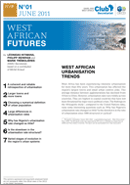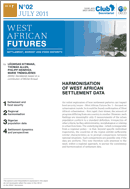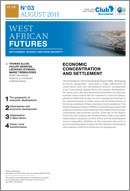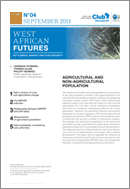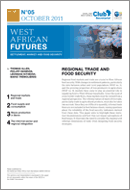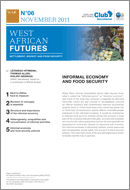WAF Briefing Notes & Working Papers

The Future of Saharo-Sahelian Areas
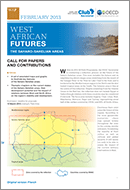 |
Call for Papers: Reflection on the future of the Saharo-Sahelian areas February 2013 Within its 2013-14 Programme of Work, the SWAC Secretariat is conducting a reflection process on the future of the Saharo-Sahelian areas. The future of the region is subject to serious worries. According to the most pessimistic scenarios, chaos may spread widely throughout the zone in the coming months and years, threatening regional stability with possible repercussions to the African continent and to global security as a whole. However, “The Saharo-Sahelian areas have an enormous development potential, which could also benefit the whole West Africa region; the Saharo-Sahelian’s future depends largely on deeper economic and political co-operation with North Africa.” This hypothesis is the starting point of a reflection which will be explored and developed in detail over an 18-month period. It will result in an Atlas consisting of a description of the area, maps and thematic chapters.
|
Settlement, Market, Food Security
|
West African urbanisation trends WAF no. 1, June 2011 Problems of data reliability, differing definitions and the incomparability of different information sources are identified. Estimates of West Africa’s urban population differ widely between UN and Africapolis data, which is based on censuses, satellite and aerial images. Nigeria is a particular important example; the 2000 population estimates differ by 14 million people. Africapolis, applying the same definition for urban populations since 1950, provides invaluable data for tracing regional dynamics and cross-country comparisons. |
|
|
Harmonisation of West African settlement data WAF no. 2, July 2011 West African countries have sufficiently similar characteristics to prompt comparisons between national situations. Such comparisons are only possible with uniform data. This note calls attention to the need, within a regional approach, to pursue the consistency and harmonisation of settlement data. No regional study provides tangible elements of harmonisation for estimates of the rural population. Parity of urban and rural population could be reached sooner than expected, and the growth rate of the population should consequently slow down more sharply, with clear implications for co-ordinated management of food insecurity. |
|
|
Economic concentration and settlement WAF no. 3, August 2011 Drawing on the World Bank’s World Development Report 2009, “Reshaping economic geography”, this note analyses the ongoing rural-urban transition, and places the link between urbanisation and economic growth in a food security perspective. The ratio between urban and rural populations, U/R ratio, is a major indicator used in food security policies, as it provides a first approximation of the ratio between non-food producing consumers (mainly urban) and food producers (mainly rural). The U/R ratio – which nearly quadrupled from 1960 to 2000 – provides important information on the agriculture sector’s capacity to meet demand from a growing population. |
|
|
Agricultural and non-agricultural population WAF no. 4, September 2011 The agricultural population does not exclusively live in rural areas; agricultural producers can also be found in urban settings. Similarly, a significant proportion of the rural population are not food-producers. The relative proportions of food producers and non-producers vary with the size of the urban agglomerations and also depend on the level of economic development. This note highlights the difficulty of measuring and monitoring the ratio between agricultural and non-agricultural populations (AP/NAP ratio), an essential indicator for managing food security policy. Given the absence of coherent and harmonised data, only modelling can in the short- to medium-term provide decision-makers with consistent data on changes in this ratio. |
|
|
Regional trade and food security WAF no. 5, October 2011 Regional food markets and trade are crucial to West African food security. With a growing number of non-food producers, markets have come to play an essential role in assuring West African households’ food security. Given the scale of cross-border trade flows (much of which are unrecorded), these markets must be viewed from a regional perspective. Informal trade flows are not included in food balance sheets, which raises questions about the reliability of food security indicators derived from these data. This paper highlights these inconsistencies and how they can impact perceptions of food issues. It also illustrates the importance of considering the regional and informal dimensions of trade. |
|
|
Informal economy and food security WAF no. 6, November 2011 It would be misleading to address food security without taking into account a large part of the economy that provides jobs, income and essential services for the urban population and for the non-agricultural population in rural areas. Despite its important role, however, the informal economy is still poorly defined, poorly measured and consequently, poorly incorporated into food security policies. This note assesses the overall size and importance of the informal economy in the West African region and takes a closer look at the way it operates. |
|
|
|
Working document
This conceptual note outlines the analytical framework of this two-year reflection cycle and makes proposals on studies that need to be conducted. It was discussed at the first Working group meeting on 17 March 2011. |
Related Documents


